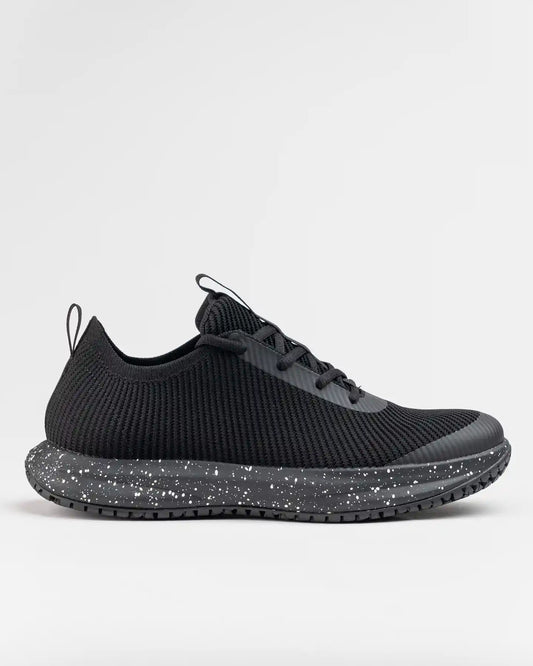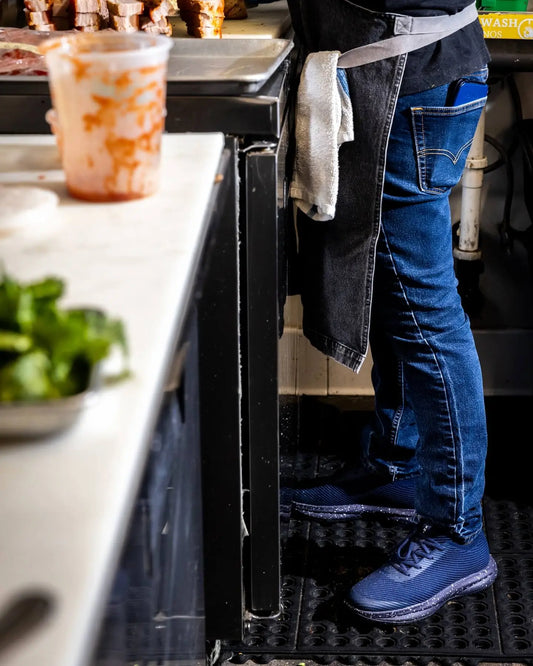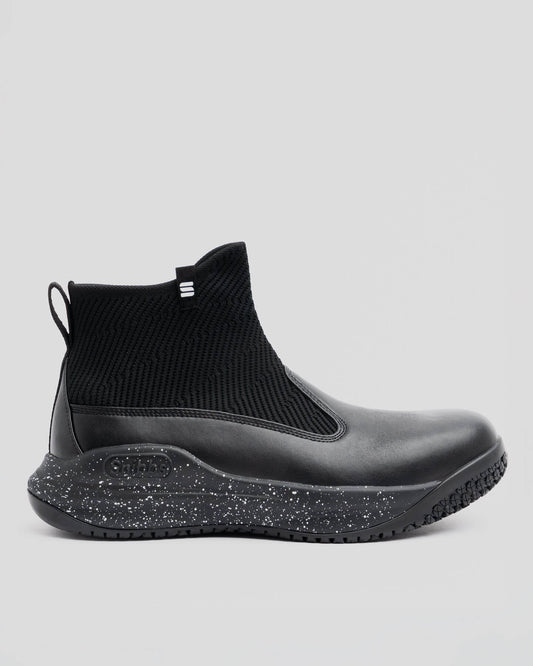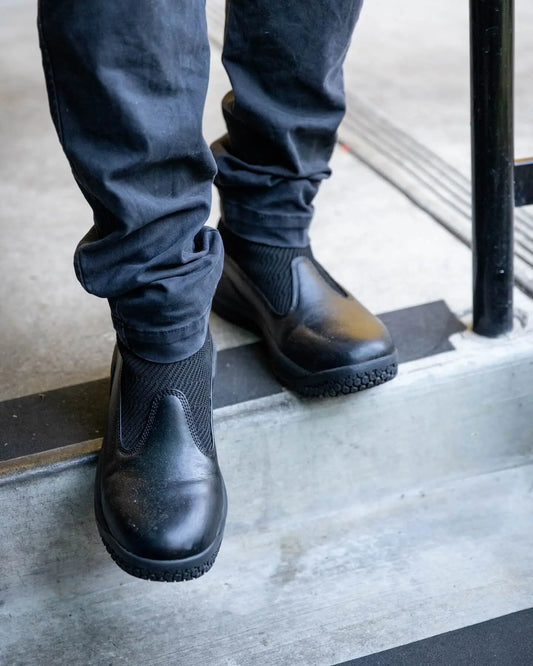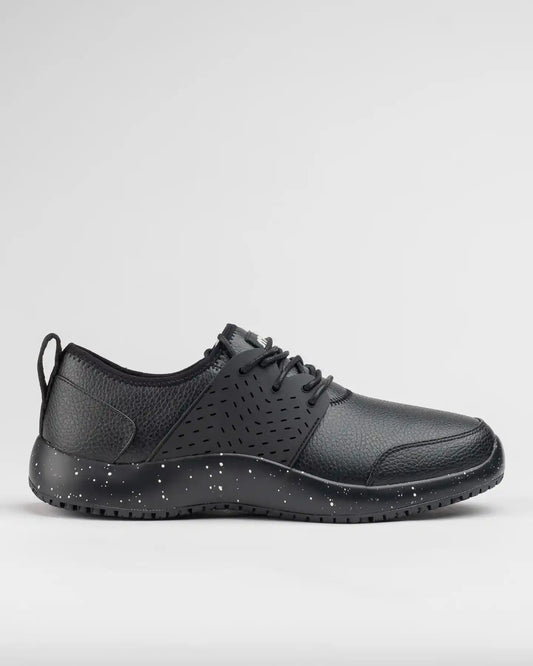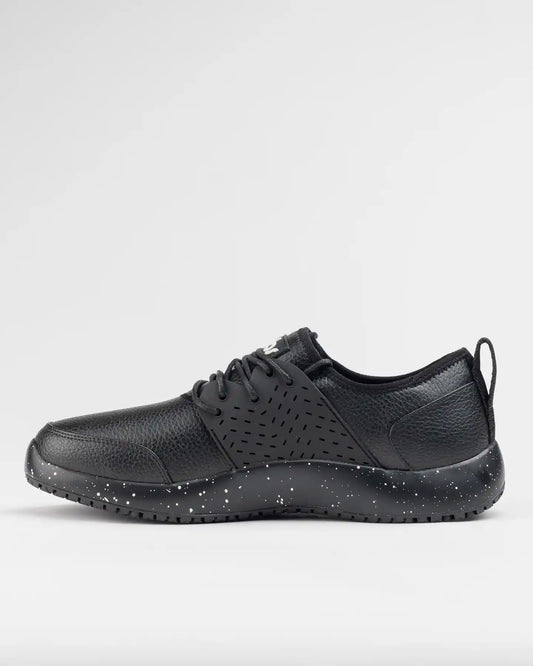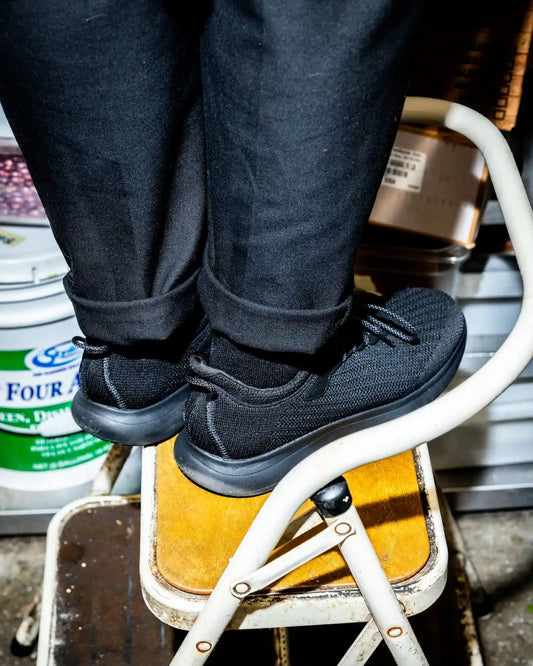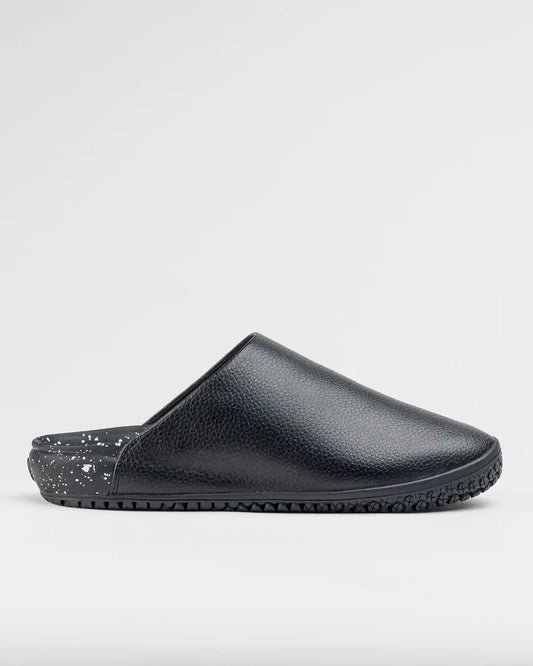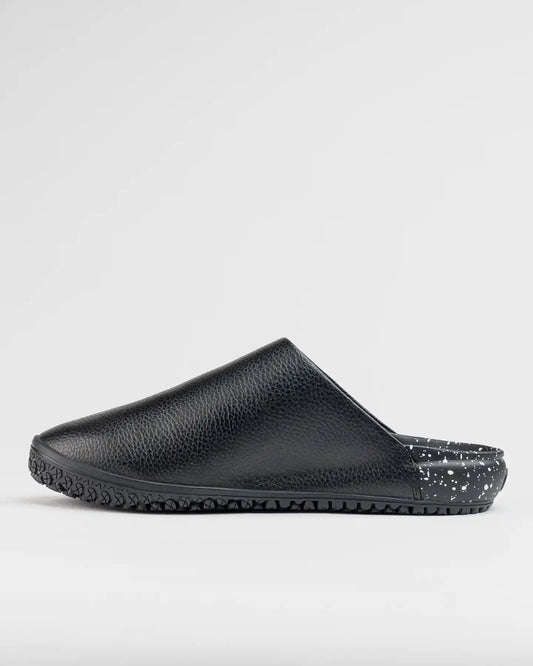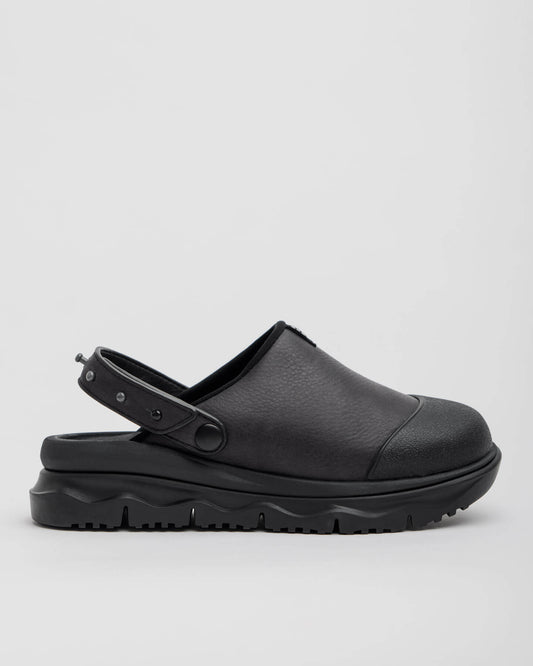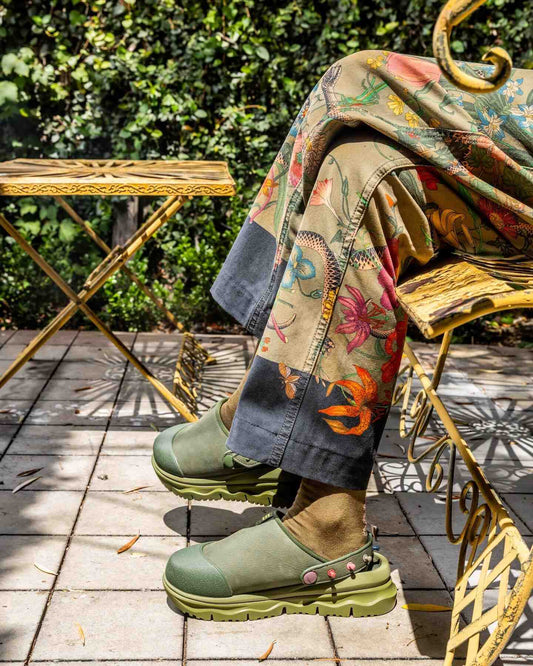How to Stop Your Feet From Hurting At Work
Alex Kinejara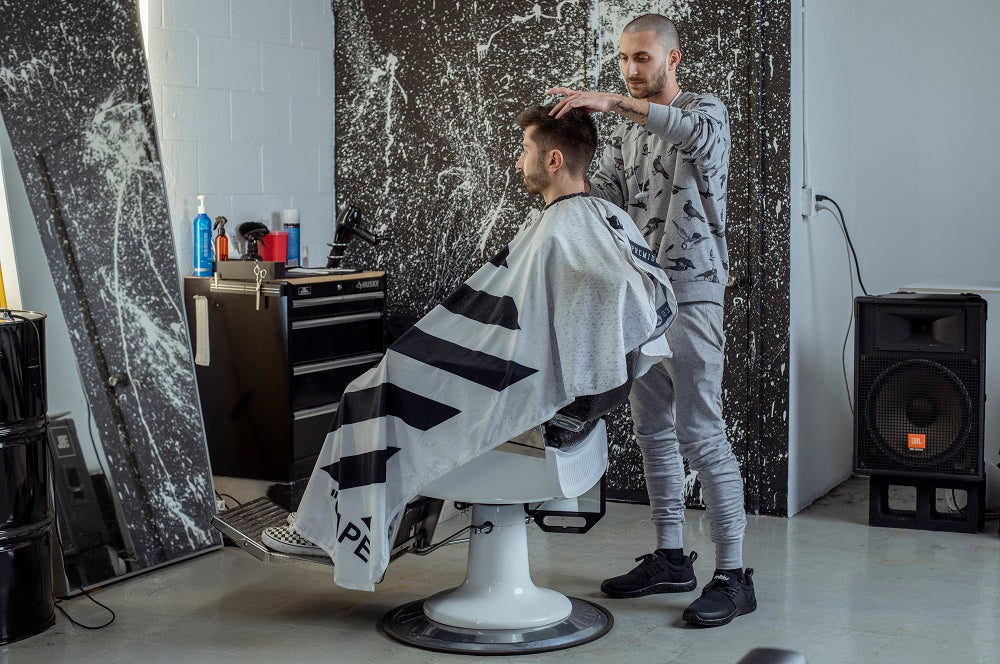
Whether you’re an elementary school teacher zipping from desk to desk to help with assignments or a medical professional darting between charts, appointments, and consultations, one thing’s for sure—a pair of aching feet can turn a productive day into a painful one.
But if you’re wondering how to stop your feet from hurting at work, you’re not alone. In fact, around 87% of individuals in the US will experience foot pain at some point in their lives.1 Thankfully, there are several steps (pun intended) you can take to reduce your foot pain at work.
From building strength to rocking slip resistant shoes what we do and wear play a role in helping prevent foot pain. We’re going to answer some of the most common questions about professional foot pain, and walk you through how to keep your feet from hurting at work.
Preventative Care for Foot Pain
Oftentimes the best way to help your feet feel their best is to prepare them for the long, exciting day ahead with proper foot care. These are some of the simplest and most effective ways to keep your feet from hurting at work:
Find Supportive and Comfortable Fitted Shoes
Shoes may be the leading cause of chronic foot pain and choosing supportive comfortable shoes can make all the difference. The right pair of shoes can prevent pain in the ball, arch, and heel of the foot. They can even prevent lower back pain.2
The best kinds of shoes to help reduce and prevent foot pain should provide extra cushion and shift your stance to an optimal foot-supporting position so that you can enjoy an ache-free day.
When evaluating which shoe is right for you, pay attention to the following characteristics:
-
Heel and arch support – The heel and the arch take on the brunt of your weight as you manage your day’s to-do list. Shoes with heel and arch cushioning make it easier for these areas of the foot to handle each step without the extra strain.
-
Width – When looking for a shoe that can support you throughout your shift, you may want to consider a wider shoe than your usual size. As you move throughout your day, your feet actually expand.3 The longer you’re on your feet during your work hours, the more they’ll expand. As you try on shoes, check to see if there’s room on either side of your foot. If it’s too tight, move up a half size and give that a try.
- Weight – When your feet are weighed down by heavy shoes, they wind up doing more work. Lighten the load by opting for a pair of lightweight work shoes made of material such as synthetic polyester or mesh.
When your shoes don't fit comfortably and properly, this can lead to numerous foot problems and causing you pain all day.
Compression Socks
Wearing a well-designed pair of compression socks while at work can help promote blood flow and oxygen for your feet and calves. This can reduce leg fatigue and swelling, as well as lower the risk of developing blood clots.
There are different levels of compression, including:
- Low
- Medium
- High
Of course, you also want to make sure any compression socks you choose are genuinely comfortable socks as well. For example, Snibbs compression socks are made with seamless toes and cooling mesh material to keep your feet comfortable throughout the day.
Fuel Up to Prevent Cramping
Besides the proper footwear, your diet can play a role in muscle and foot health. Foot cramps can strike at any moment. To fend off that sudden sharp ache, it can help to add cramp-fighting foods and beverages to your daily routine, including:
Build Up Your Foot Strength
As soon as you set foot into your workplace, your feet begin their day-long workout. To help them tackle the challenges of the day, you can
-
Try picking up marbles with your toes. It’s harder than you think!
-
Practice shifting your weight to your tip-toes, lifting your heels in the air for a few moments before setting them down again.
- Point your toes like a ballerina and release. Want to add a little heat? Grab a resistance band and take a seat. Loop a resistance band over the pad of your foot and hold onto either side of the band. Then, point your toes and release for a foot and calf workout.
What You Can Do During the Work Day to Ease Foot Pain
Foot pain can clock in anytime, anywhere—especially if you’re on your feet all day at work. Thankfully, there are a few things you can do on the job to help support your feet.
Stretch at Work
When time allows, gently stretching your feet throughout your work day helps keep the muscles in and around your feet loose and relaxed.
Try this quick stretch to give your hard-working feet a mini yoga session:
-
Stand on the edge of the stairs—or some other slightly raised area where you can hold a railing for balance—with your toes on the step and your heels out over the edge.
- Slowly let your heels sink below the step level until you feel a stretch.
For a milder version of this stretch, simply stand on a flat surface, and lower yourself slightly by bending your knees and keeping your feet flat on the ground, similar to a dancer’s plié.
Sit Down During Your Breaks
When it’s time for your break, don’t forget to give your toes some downtime too by taking a seat. Sitting for a few minutes helps to ease the pressure of your body weight and allows the muscles of your feet to relax and recuperate.
Addressing Foot Pain After the Work Day
Prolonged standing or walking can sometimes cause pain beyond the comfort of a supportive shoe. Aftercare can do so much good for your hard-working toes. Think of it this way—when an athlete walks off the field, they often have a special routine to care for their body so they can be in top shape for the next game.
While it’s always best to talk directly to a medical professional about your specific situation, these are some common strategies to help your feet recover from long days and prepare for the next challenge.
Stretch at Home
If you don’t have time to stretch your feet and calves at work, stretching when you get home is also a stellar option to help your muscles relax after a day of hard work. Even better, there are also several stretches you can do from the comfort of your couch.5
Follow these steps for an easy stretch that can help loosen your muscles and ease foot tension:
-
Sit on a chair with both feet on the ground and a small towel directly in front of you.
-
With your toes, grip the towel and scrunch it toward your heels.
- Relax your feet, then repeat the exercise five times.
You can also try a stretch that gives your calves and feet some extra TLC:
-
Take a seat and cross your right heel over your left leg, so that the outside of your right shin is propped up by your knee.
-
With your right hand, grab your right toes and gently pull them back toward your shin.
-
Place your left hand on the bottom of your right foot to feel for any tension.
-
Hold for ten seconds, then relax.
Repeating this stretch two to three times for both your right foot and your left should help you relieve muscle pain in your feet.
Massage Your Feet
A post-work foot massage can be a self-care treat and a beneficial practice for the health of your feet. If you want an alternative to using your hands, you can sit down and roll your foot back and forth over a tennis ball or golf ball for about two minutes to loosen your foot’s muscles.5
Ice, Elevation, and Rest
If you’re experiencing pain after standing throughout your shift, one way to relieve discomfort and promote healing is by icing and elevating the foot that hurts.6
Follow these steps to promote pain relief and healing:
-
Ice – You typically want to apply ice for about twenty minutes. Icing reduces blood flow to the area, which in turn reduces the swelling.
-
Elevate – You can elevate the foot by lying down and placing it on a pillow, so that it’s above heart level.
- Rest – Lastly, resting your feet will help them heal.
To Ease Foot Pain at Work, Choose Snibbs
No matter where you work or what your profession is, your feet support you through every step of your day. When you start to experience aches and pains in your feet, your body is sending a clear message: to take care of yourself so you can do your best work on and off the clock. It’s time to choose health, comfort, and support in every step.
It’s time to choose Snibbs.
When it comes to stopping your feet from hurting at work, Snibbs work shoes are one of the best choices you can make. We combine specially engineered support, all-day comfort, and style to give your feet everything they need during the workday. Plus, they’re made of durable materials that make Snibbs a long-term solution, not a quick fix.
You don’t have to suffer through hurt feet alone. You’re a talented professional who deserves support, and we’re here to help—so you can go back to making your mark on the world.
Sources:
- HealthinAging. Foot Problems. https://www.healthinaging.org/a-z-topic/foot-problems/basic-facts#
- StartStanding. How Your Footwear May Be Causing Your Back Pain. https://www.startstanding.org/footwear-causing-back-pain/
- Harvard Health Publishing. What’s Causing Those Swollen Feet? https://www.health.harvard.edu/diseases-and-conditions/whats-causing-those-swollen-feet#
- Wentworth-Douglass Hospital. Nutrition Tips to Prevent Cramps. https://www.wdhospital.org/wdh/services-and-specialties/orthopedic-care/blog/nutrition-tips-to-prevent-cramps
- Medical News Today. Best stretches and exercises for plantar fasciitis and heel pain. https://www.medicalnewstoday.com/articles/324353
- Healthline. What You Need to Know About Foot Pain. https://www.healthline.com/health/foot-pain
- Healthline. Plantar Fasciitis Stretches to Soothe Heel Pain. https://www.healthline.com/health/fitness-exercise/plantar-fasciitis-stretches
- Journal of Family Medicine and Primary Care. The prevalence of foot pain and its associated factors among Saudi school teachers in Abha sector, Saudi Arabia. https://journals.lww.com/jfmpc/Fulltext/2020/09090/The_prevalence_of_foot_pain_and_its_associated.26.aspx
- Performance Therapies, P.C. If your feet hurt, you’re probably tying your shoes wrong. Give these lacing techniques a try. https://ptforhealth.com/do-you-suffer-from-foot-pain-have-you-tried-lacing-your-shoes-differently/

